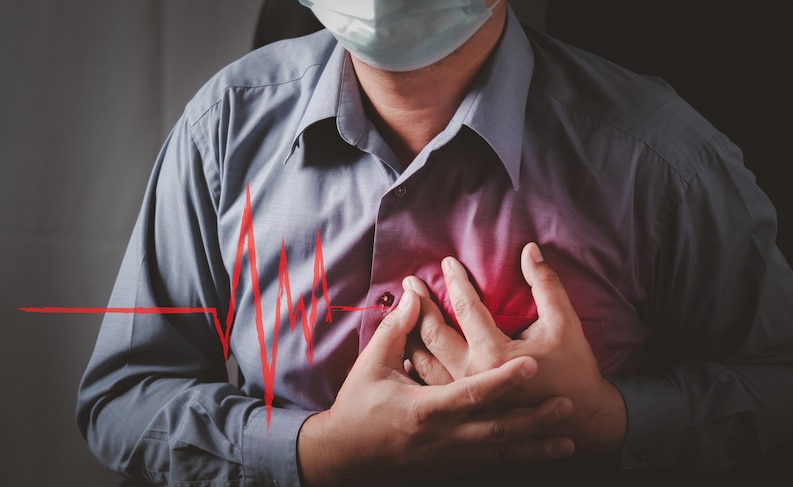What was the last time when you heard the word heart attack or heart stroke? Evidently, almost every day!
Heart attacks are becoming as common as fevers!
Did you know heart disease is the leading cause of death in the United States and even throughout the world, claiming a life every 33 seconds and accounting for 1 in 5 deaths, with an annual economic impact of $239.9 billion?
A heart attack, also known as myocardial infarction, can be the outcome of a blockage in the blood flow to the heart, leading to damage or death of heart muscle cells. It is a medical emergency that requires immediate attention and treatment.
The worse part, sometimes it comes with no warning signs!
In this round-up, we will take a closer look at this threatening heart disease, its causes, early signs, and possible treatments to easily identify if it is a normal chest pain or heart attack!
What is Heart Attack?
A heart attack, also known as myocardial infarction, occurs when the blood flow to the heart muscle is blocked, usually due to a clot in a coronary artery. This blockage prevents oxygen and nutrients from reaching the heart, causing damage or death to the heart muscle. Symptoms may include chest pain or discomfort, shortness of breath, nausea, and fatigue. Prompt medical attention is crucial to minimize heart muscle damage and improve chances of survival.

Threatening Facts about Heart Attacks
- Heart disease is the top cause of mortality in the United States, affecting men, women, and individuals from various racial and ethnic backgrounds.
- In the USA, every 33 seconds, death occurs due to heart or cardiovascular disease.
- In 2021, nearly 695,000 lives led to death from heart disease single in the USA, equivalent to — 1 in every 5 deaths.
- From 2018 to 2019, the economic impact of heart disease in the United States amounted to around $239.9 billion, considering the costs associated with healthcare services, pharmaceuticals, and the productivity gap caused by premature mortality.
Signs and Symptoms
The common signs and symptoms of a heart attack include:
- Chest pain or discomfort: This is often described as a tightness, squeezing, or pressure in the chest. It may last for a few minutes or come and go.
- Upper body pain: Pain or discomfort may be felt in the arms, neck, jaw, shoulder, or back.
- Shortness of breath: Difficulty in breathing or feeling breathless even at rest or with minimal exertion.
- Sweating: Profuse sweating or cold, clammy skin.
- Nausea and vomiting: Some individuals may experience nausea or indigestion-like symptoms.
- Dizziness or lightheadedness: Feeling dizzy or fainting can occur during a heart attack.

It is important to note that not everyone experiences the same symptoms, and they can vary between men and women. Some individuals may have atypical symptoms such as fatigue, weakness, or sudden onset of unexplained anxiety.
How do I know if it is a normal chest pain or heart attack?
According to American Heart Association, there are certain indicators that can help differentiate between normal chest pain and a heart attack. Chest pain associated with a heart attack is often described as a sensation of pressure, squeezing, or tightness in the chest that may radiate to the arms, jaw, or back. It is typically accompanied by other symptoms like shortness of breath, nausea, lightheadedness, and sweating.
On the other hand, normal chest pain, often referred to as musculoskeletal or non-cardiac chest pain, is usually caused by factors like muscle strain, acid reflux, or anxiety. It tends to be localized and may worsen with certain movements or breathing deeply. Physical activity or changes in body position may also influence the intensity of the pain.
However, it is crucial not to self-diagnose. If you experience any chest discomfort, especially if you’re at risk for heart disease or have other risk factors, it is essential to seek immediate medical attention. Only a healthcare professional can accurately assess your symptoms, conduct tests, and provide a definitive diagnosis.
Remember, when it comes to chest pain, erring on the side of caution is always the best approach. Consulting trusted medical sources and seeking medical help promptly can help ensure your well-being and provide you with the appropriate care.
Possible Reasons for Heart Attack
A heart attack usually occurs when there is a blockage in one or more coronary arteries, which supply oxygen-rich blood to the heart. The blockage is typically caused by the buildup of fatty deposits called plaque. When the plaque ruptures, it can form a blood clot that obstructs the artery, leading to a heart attack.
Several risk factors contribute to the development of heart attacks, including:
- Age: The risk increases with age, especially for men over 45 and women over 55.
- Gender: Men are generally at a higher risk of heart attacks, but the risk for women increases after menopause.
- Family history: Having a family history of heart disease, particularly a parent or sibling, increases the risk.
- Smoking: Smoking damages blood vessels and significantly increases the risk of heart attacks.
- High blood pressure: Uncontrolled high blood pressure puts strain on the heart and arteries, increasing the risk.
- High cholesterol: Elevated levels of cholesterol in the blood contribute to the formation of plaque in the arteries.
- Obesity and sedentary lifestyle: Being overweight or leading a sedentary lifestyle increases the risk of heart attacks.
- Diabetes: People with diabetes have a higher risk of developing heart disease, including heart attacks.
- Stress: Chronic stress and excessive stress responses can contribute to the development of heart disease.
- Poor diet: Consuming a diet high in saturated fats, trans fats, salt, and low in fruits, vegetables, and fiber increases the risk.

Gender Disparities in Heart Attack Symptoms
Is there any difference between male & female heart attacks?
Heart attack symptoms can vary among individuals regardless of their sex or gender. However, there are notable differences in how heart attacks are present, the biological factors involved, and the outcomes based on sex.
Research from 2019 discovered that both men and women commonly experience chest pain during a heart attack. Women often describe the pain as tightness, squeezing, or pressure in the chest, while men typically characterize it as a “heavy weight on the chest.”
According to the American Heart Association (AHA), women may be more likely than men to have additional heart attacks symptoms such as shortness of breath, nausea, vomiting, upper back or jaw pain, dizziness, lightheadedness, and extreme fatigue.
Estrogen levels play a role in reducing the risk of heart attacks, making women more susceptible to experiencing a heart attack after menopause.
Unfortunately, women who have a heart attack are at a higher risk of underdiagnosis and undertreatment. Studies have shown that women tend to delay seeking emergency medical services despite experiencing typical heart attack symptoms and also face long delays in receiving treatment once in an emergency setting, as highlighted by a 2018 Swiss study.
What to do if you or someone encounter a heart attack?
If you or someone is experiencing a heart attack, it is crucial to act quickly. Call emergency services immediately (such as 911 in the United States) and inform them about the situation. Encourage the person to rest and try to keep them calm. If they are conscious and not allergic, giving them aspirin (chewed) can help. Avoid letting the person exert themselves and closely monitor their condition. Do not attempt to drive to the hospital yourself unless there is no other option. Timely medical intervention is vital, so prioritize getting professional help as soon as possible.
Heart Attack Treatment
If you have experienced a heart attack, your doctor may suggest various procedures, either surgical or nonsurgical, to address the issue and reduce the risk of future heart attacks.
These procedures commonly include:
- Stent: Surgeons place a wire mesh tube, known as a stent, into the artery to keep it open after performing angioplasty.
- Angioplasty: By using a balloon or removing plaque buildup, angioplasty aims to open the blocked artery. It is important to note that angioplasty is rarely used as a standalone treatment nowadays.
- Heart bypass surgery: This procedure involves redirecting the blood flow around the blockage, improving circulation.
- Heart valve surgery: Surgeons repair or replace faulty valves, either through repair techniques or valve replacement surgery, to enhance the heart’s pumping capability.
- Pacemaker: Implanted beneath the skin, a pacemaker assists in maintaining a normal heart rhythm.
- Heart transplant: In severe cases where a heart attack results in significant damage, a heart transplant may be recommended to replace the extensively affected heart tissue.
In addition to these procedures, your doctor may prescribe medications as part of your heart attack treatment. These may include aspirin, clot-dissolving drugs, blood thinners, pain relievers, nitroglycerin, blood pressure medication, and beta-blockers.

Timely treatment plays a crucial role in heart attack cases. The sooner you receive treatment after a heart attack, the faster blood flow can be restored to the affected area of the heart, improving the chances of a successful recovery.
Possible Prevention
It is essential to be aware of these risk factors and take preventive measures to reduce the likelihood of experiencing a heart attack. This includes adopting a healthy lifestyle, managing stress, maintaining a balanced diet, exercising regularly, and seeking regular medical check-ups to monitor and manage risk factors.
Bottom Line
Recognizing the signs and symptoms of a heart attack, understanding its causes and risk factors, and taking appropriate actions are crucial for prompt medical intervention and increased chances of survival. Immediate medical assistance should be sought if you or someone else is experiencing symptoms of a heart attack. Remember, every minute matters during a heart attack, and timely treatment can save lives!






